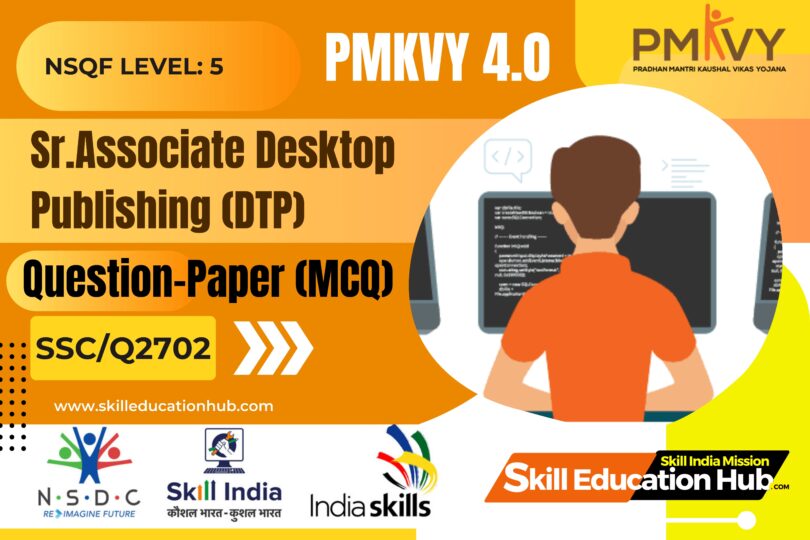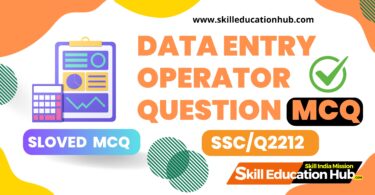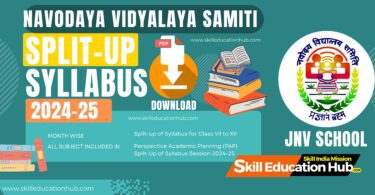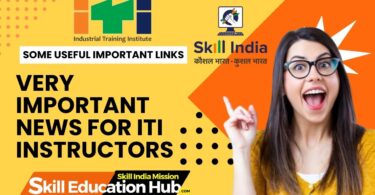Sr.Associate Desktop Publishing (DTP) Question-Paper (MCQ) This course equips individuals with the necessary skills to pursue careers in desktop publishing, graphic design, and related fields, catering to the growing demand for digital content creation across various industries.
- Criteria for assessment for each Qualification File will be created by the Sector
Skill Council. Each Performance Criteria (PC) will be assigned marks
proportional to its importance in NOS. SSC will also lay down proportion of
marks for Theory and Skills Practical for each PC. - The assessment for the theory part will be based on knowledge bank of
questions created by the SSC. - Assessment will be conducted for all compulsory NOS, and where applicable,
on the selected elective / option NOS/set of NOS - Individual assessment agencies will create unique question papers for theory
part for each candidate at each examination/training center (as per assessment
criteria below) - Individual assessment agencies will create unique evaluations for skill practical
for every student at each examination/training center based on this criterion - To pass a QF, a trainee should score an average of 70% across generic NOS’
and a minimum of 70% for each technical NOS - In case of unsuccessful completion, the trainee may seek reassessment on the
Qualification File.
| Question | Options | Answer |
|---|---|---|
| What are the main responsibilities of a Senior Associate in desktop publishing? | A. Formatting text and images | |
| B. Managing access to publications | ||
| C. Providing technical support | ||
| D. All of the above | ||
| What is the significance of effective communication in the role of a Senior Associate? | A. To control access to publications | |
| B. To coordinate with team members | ||
| C. To manage printing equipment | ||
| D. To design publication layouts | ||
| Which of the following is NOT a duty of a Senior Associate in desktop publishing? | A. Resolving customer queries | |
| B. Ensuring data security | ||
| C. Managing printing production | ||
| D. Providing technical guidance | ||
| What skills are important for a Senior Associate in desktop publishing? | A. Software proficiency | |
| B. Project management | ||
| C. Typing speed | ||
| D. Sales negotiation | ||
| Why is teamwork essential for a Senior Associate in desktop publishing? | A. To manage printing equipment | |
| B. To foster creativity | ||
| C. To work effectively with colleagues | ||
| D. To increase software proficiency | ||
| Which of the following tasks might a Senior Associate perform in desktop publishing? | A. Managing social media accounts | |
| B. Designing publication layouts | ||
| C. Cooking lunch for the team | ||
| D. Driving company vehicles | ||
| What role does a Senior Associate play in maintaining data security in desktop publishing? | A. Providing technical support | |
| B. Managing access to publications | ||
| C. Typing speed | ||
| D. Sales negotiation | ||
| How does a Senior Associate contribute to project management in desktop publishing? | A. By managing printing production | |
| B. By coordinating with team members | ||
| C. By designing publication layouts | ||
| D. By providing customer support | ||
| What is the importance of attention to detail for a Senior Associate in desktop publishing? | A. To ensure data security | |
| B. To manage printing equipment | ||
| C. To foster creativity | ||
| D. To avoid errors in publication |
2. Concept of Publications
| Question | Options | Answer |
|---|---|---|
| What are the different types of publications? | A. Print, digital, online | |
| B. Print, digital, audio | ||
| C. Print, audio, video | ||
| D. Print, video, online | ||
| Why are publications important in communication? | A. To entertain audiences | |
| B. To disseminate information | ||
| C. To conduct research | ||
| D. To play games | ||
| Which format is NOT commonly used for publications? | A. PDF | |
| B. MP3 | ||
| C. JPEG | ||
| D. DOCX | ||
| What is the primary purpose of publications? | A. To store information | |
| B. To communicate information | ||
| C. To destroy information | ||
| D. To hide information | ||
| What do publications include? | A. Text, images, videos | |
| B. Text, images, audio | ||
| C. Text, images, animations | ||
| D. Text, images, code | ||
| Which of the following is NOT a characteristic of publications? | A. Dynamic | |
| B. Static | ||
| C. Interactive | ||
| D. Transparent | ||
| How do publications contribute to knowledge dissemination? | A. By hiding information | |
| B. By storing information | ||
| C. By communicating information | ||
| D. By destroying information | ||
| What role do publications play in education? | A. To complicate information | |
| B. To simplify information | ||
| C. To hide information | ||
| D. To confuse information | ||
| Why are publications considered effective communication tools? | A. They are dynamic | |
| B. They can reach a wide audience | ||
| C. They are interactive | ||
| D. All of the above |
These questions cover the basic concepts and significance of publications. Adjustments can be made according to the specific focus and level of the exam. Let me know if you need further assistance!
Sr.Associate Desktop Publishing (DTP)Question-Paper(MCQ)
- How can access to publications be controlled?
- A. By providing unlimited access to everyone
- B. By restricting access through security measures
- C. By leaving publications in public areas
- D. By randomly changing access permissions
- Which of the following is a security measure to control access to publications?
- A. Using strong passwords and encryption
- B. Sharing access credentials with everyone
- C. Storing publications in an unsecured location
- D. Allowing access without authentication
- What is the purpose of controlling access to publications?
- A. To make publications easily accessible
- B. To ensure only authorized individuals can access sensitive information
- C. To increase the printing speed
- D. To share publications with competitors
- Who should have access to sensitive publications?
- A. Anyone who requests access
- B. Only authorized personnel with a legitimate need
- C. Everyone in the organization
- D. No one, sensitive publications should not be shared
- Which of the following is NOT a method to provide controlled access to publications?
- A. Implementing user authentication
- B. Using access control lists (ACLs)
- C. Publishing all content on public websites
- D. Utilizing role-based access control (RBAC)
- What is the role of encryption in controlling access to publications?
- A. It ensures publications are always accessible
- B. It protects publications from unauthorized access by encrypting data
- C. It slows down access to publications
- D. It allows unlimited sharing of publications
- What can happen if access to sensitive publications is not controlled?
- A. Increased security and protection
- B. Unauthorized disclosure of confidential information
- C. Improved collaboration among team members
- D. Faster distribution of publications
- How can access control contribute to compliance with regulations?
- A. By allowing unrestricted access to publications
- B. By ensuring only authorized personnel can access sensitive information
- C. By delaying access to publications
- D. By sharing publications publicly
- What is the importance of regularly reviewing access permissions?
- A. To complicate access to publications
- B. To ensure access permissions are up-to-date and aligned with organizational needs
- C. To restrict access to publications
- D. To delete all access permissions
- Which department or role is typically responsible for managing access to publications?
- A. Human Resources
- B. IT Department
- C. Marketing Department
- D. Customer Service Department
Sr.Associate Desktop Publishing (DTP)Question-Paper(MCQ)
- Which software is commonly used for desktop publishing?
- A. Microsoft Word
- B. Adobe InDesign
- C. Microsoft Excel
- D. Google Docs
- What is the purpose of formatting text and images in publishing content?
- A. To make the content visually appealing and readable
- B. To increase the file size
- C. To confuse readers
- D. To decrease the printing quality
- Which file format is commonly used for print publications?
- A. JPG
- B. PNG
- C. PDF
- D. GIF
- What is the importance of ensuring compatibility with standard formats?
- A. To make the content less accessible
- B. To limit the audience reach
- C. To ensure the content can be accessed and viewed across different platforms
- D. To increase the printing cost
- Which software feature is used for adjusting the layout of content?
- A. Spell check
- B. Alignment tools
- C. Copy and paste
- D. Font selection
- How can images be optimized for publishing content?
- A. By reducing resolution and quality
- B. By increasing file size
- C. By adding unnecessary effects
- D. By using copyrighted images
- What is the purpose of compressing files in publishing content?
- A. To increase file size
- B. To improve printing quality
- C. To decrease loading times and save storage space
- D. To make files unreadable
- Which software tool is commonly used for image editing in desktop publishing?
- A. Adobe Photoshop
- B. Microsoft PowerPoint
- C. Adobe Illustrator
- D. Microsoft Paint
- What role does file format play in publishing content?
- A. It doesn’t affect the publishing process
- B. It determines how the content is displayed and printed
- C. It limits access to the content
- D. It increases the file size unnecessarily
- Why is it important to follow industry-standard formats for publishing content?
- A. To make the content less accessible
- B. To limit the audience reach
- C. To ensure compatibility and consistency across platforms and devices
- D. To increase printing costs
- Which software is commonly used for desktop publishing?
- A. Microsoft Word
- B. Adobe InDesign
- C. Microsoft Excel
- D. Google Docs
- What is the primary function of desktop publishing software?
- A. Creating spreadsheets
- B. Editing videos
- C. Designing layouts for print and digital publications
- D. Sending emails
- Which feature of desktop publishing software allows users to manipulate text and images?
- A. Spell check
- B. Copy and paste
- C. Alignment tools
- D. Font selection
- Which software is commonly used for image editing in desktop publishing?
- A. Adobe Photoshop
- B. Microsoft Word
- C. Adobe Illustrator
- D. Microsoft Excel
- What is the purpose of using desktop publishing software in the publishing process?
- A. To complicate the process
- B. To simplify layout design and formatting
- C. To increase printing costs
- D. To decrease productivity
- How does desktop publishing software contribute to the creation of visually appealing publications?
- A. By adding unnecessary elements
- B. By simplifying layout design and formatting
- C. By increasing file size
- D. By reducing printing quality
- Which software tool allows users to adjust the layout of content in desktop publishing software?
- A. Spell check
- B. Alignment tools
- C. Copy and paste
- D. Font selection
- What role does desktop publishing software play in ensuring compatibility with industry-standard formats?
- A. It limits compatibility
- B. It increases printing costs
- C. It ensures compatibility across different platforms and devices
- D. It decreases file size unnecessarily
- Which software feature allows users to preview and export publications in different file formats?
- A. Font selection
- B. Alignment tools
- C. Export options
- D. Spell check
- How does desktop publishing software contribute to the efficiency of the publishing process?
- A. By slowing down the process
- B. By simplifying layout design and formatting
- C. By increasing printing costs
- D. By decreasing productivity
- What is the role of prepress tasks in the production process of publishing content?
- A. They involve printing the final publication
- B. They occur after the publication is distributed
- C. They include activities such as proofreading and color correction
- D. They are not essential for the production process
- Which of the following is NOT a prepress task in publishing content?
- A. Proofreading
- B. Color correction
- C. Printing
- D. Imposition
- What is the purpose of proofreading in the production process of publishing content?
- A. To increase errors in the publication
- B. To ensure accuracy and correct any errors in the content
- C. To delay the production process
- D. To skip the printing step
- What is imposition in the production process of publishing content?
- A. It involves printing the final publication
- B. It occurs after the publication is distributed
- C. It is the arrangement of pages for printing
- D. It is not necessary for the production process
- How does color correction contribute to the production process of publishing content?
- A. By increasing errors in the publication
- B. By ensuring consistency and accuracy of colors
- C. By delaying the production process
- D. By skipping the printing step
- Which software tool is commonly used for color correction in the production process of publishing content?
- A. Adobe Photoshop
- B. Microsoft Word
- C. Adobe Illustrator
- D. Microsoft Excel
- What role does quality control play in the production process of publishing content?
- A. It increases errors in the publication
- B. It ensures that the final publication meets quality standards
- C. It delays the production process
- D. It skips the printing step
- Why is it important to ensure accuracy and consistency in the production process of publishing content?
- A. To increase errors in the publication
- B. To maintain the quality and credibility of the publication
- C. To delay the production process
- D. To skip the printing step
- What are the consequences of not meeting production requirements in publishing content?
- A. Increased errors in the publication
- B. Lower quality and credibility of the publication
- C. Delayed production process
- D. Skipped printing step
- How can efficient production requirements contribute to the success of publishing content?
- A. By increasing errors in the publication
- B. By maintaining the quality and credibility of the publication
- C. By delaying the production process
- D. By skipping the printing step







